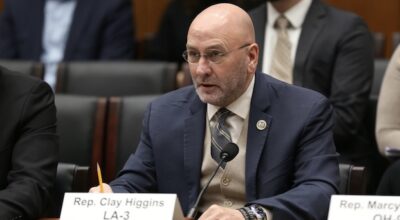Senate Democrats unveil budget blueprint
Published 2:28 pm Wednesday, March 13, 2013
WASHINGTON (AP) — Senate Democrats unveiled a largely stand-pat budget Wednesday that calls for $1 trillion in new tax revenues over the coming decade but actually increases spending, while protecting the party’s domestic policy priorities and adding $4 trillion more to the national debt than a slashing alternative from House Republicans.
The plan by Budget Committee Chairwoman Patty Murray, D-Wash., blends about $1 trillion in modest cuts to health care providers, the Pentagon, domestic agencies and interest payments on the debt with an equal amount in new revenue claimed by closing tax breaks.
But because Democrats want to restore $1.2 trillion in automatic spending cuts over the same period — cuts imposed by Washington’s failure to strike a broader budget pact — Murray’s blueprint increases spending slightly when compared with current policies.
On the other side of Capitol Hill, House Budget Committee Republicans barreled ahead with an entirely opposite approach that whacks spending by $4.6 trillion over the coming decade, promises sweeping cuts to Medicaid and domestic agencies while setting a path to balancing the government’s books within 10 years.
The House panel approved the plan, by Chairman Paul Ryan, R-Wis., late Wednesday by a 22-17 party-line vote. Murray’s plan was set to be approved by the Democratic-led Senate panel on Thursday. Both measures face floor debates next week.
Even as Democrats controlling the Senate and the strongly conservative House moved in divergent directions, President Barack Obama again traveled to the Capitol to open a dialogue with lawmakers. Wednesday’s meeting was with House Republicans, who welcomed the gesture even as they noted that deep divisions remain.
“We’ve got a big difference between us,” said Rep. Greg Walden, R-Ore. “He supports higher tax revenues.”
But Rep. Tom Cole, R-Okla., said Obama told Republicans that he also supports a revised inflation adjustment called “chained CPI” that would curb cost-of-living increases in Social Security benefits and increase tax revenue through slower indexing of income tax brackets. He also supports “means testing” for Medicare benefits that would require higher-income beneficiaries to pay more for their health care.
Cole said Obama told them everyone needs to honestly confront the political barriers to reining in popular benefit programs like Medicare and Social Security. “He said, ‘Your people don’t want entitlement reform either. Go home and poll them.'”
The White House praised the Senate plan.
“The Senate Democratic budget is a concrete plan that will grow our economy and shrink our deficits in a balanced way, consistent with the president’s belief that our economy grows best from the middle out, not the top down,” White House press secretary Jay Carney said in a statement late Wednesday.
The debate in the Senate Budget Committee was the first time since 2009 that Democrats in charge of the Senate have advanced a budget blueprint, which opened to predictably poor reviews from the panel’s Republicans, who said it’s heavy on tax increases and light on cuts to rapidly growing benefit and safety net programs.
“Is it really possible that after four years, the majority has failed to identify any reforms? That all we have is just a tax-and-spend budget that makes no alteration to our dangerous debt course?” said the top Budget Committee Republican, Sen. Jeff Sessions of Alabama. “Does the majority believe the government is perfect and requires no reform?”
At issue is the arcane and partisan congressional budget process, which involves a unique, non-binding measure called a budget resolution. When the process works as designed — which is rarely — budget resolutions have the potential to stake out parameters for follow-up legislation specifying spending and rewriting the complex U.S. tax code.
This year, it’s taken as a given that the tea party-driven House and Democratic-led Senate won’t be able to resolve their differences absent an agreement driven by the president. Obama has had two failed rounds of talks with House Speaker John Boehner, R-Ohio, and now seems to be looking to the Senate as a potential partner with which to spark a potential breakthrough.
In that context, the rival Murray and Ryan budget plans don’t seem to offer a path forward. Even a cursory look at them reveals gaping differences.
Ryan’s plan promises to cut the deficit from $845 billion this year to $528 billion in the 2014 budget year that starts in October. The deficit would drop to $125 billion in 2015 and hover pretty much near balance for several years before registering a $7 billion surplus in 2023.
Murray’s plan, by contrast, promises a $693 billion deficit in 2014, dropping to the $400 billion range for the middle years of the decade. While large, such deficits would hover just above 2 percent of gross domestic product, a level that many analysts see as economically sustainable.
Democrats warn that the slashing cuts proposed by Ryan would impose austerity that would slam the economy into a tailspin; Republicans counter that reducing the drag that spiraling debt is placing on future generations is critical to long-term economic growth.
Ryan’s plan embraces tough new spending levels required under the unpopular, across-the-board spending cuts known as a sequester that began to take effect this month. But in order to protect the Pentagon, Republicans cut even more deeply into the day-to-day operating budgets of domestic agencies next year, slashing them from the $506 billion projected under the 2011 debt and budget pact to $414 billion — an unprecedented 18 percent cut.
Over 10 years, Republicans propose cuts to non-defense agency budgets $895 billion below those envisioned less than two years ago.
House Appropriations Committee Chairman Harold Rogers, R-Ky., responsible for implementing those cuts, is declining comment. The proposed spending cuts, if not changed, are likely to hamstring efforts later this year to advance the annual spending bills for domestic agencies.
Murray’s budget, meanwhile, not only preserves the spending “caps” set in the hard-fought 2011 deal but proposes $100 billion in stimulus spending for road and bridge construction, repairing schools, and worker training.
Ryan revives his controversial plan that, starting in 2024 for workers born in 1959 or after, would replace traditional Medicare with a voucher-like government subsidy for people to buy health insurance on the open market. Murray proposes modest cuts to Medicare providers.
Ryan proposes slashing the Medicaid health care program for the poor and disabled by more than $700 billion over 10 years, while Murray would trim it by a negligible $10 billion. Ryan promises to eliminate $1.8 trillion in subsidies in the president’s health care law; Murray doesn’t touch them.
“There are no sacred cows,” Murray said. “We put everything we can on the table, but we do it in a responsible way that preserves, protects and strengthens the programs like Medicare and Medicaid that the American people strongly support.”
(Associated Press)





